Nov 16, 2020
Workation: Revitalizing rural Japan and weary office workers
How the "workation" concept of bringing work and leisure out of Japan's cities and into its rural resorts is taking on the challenge of regional revitalization, workplace reform, and remote work solution for the pandemic era.
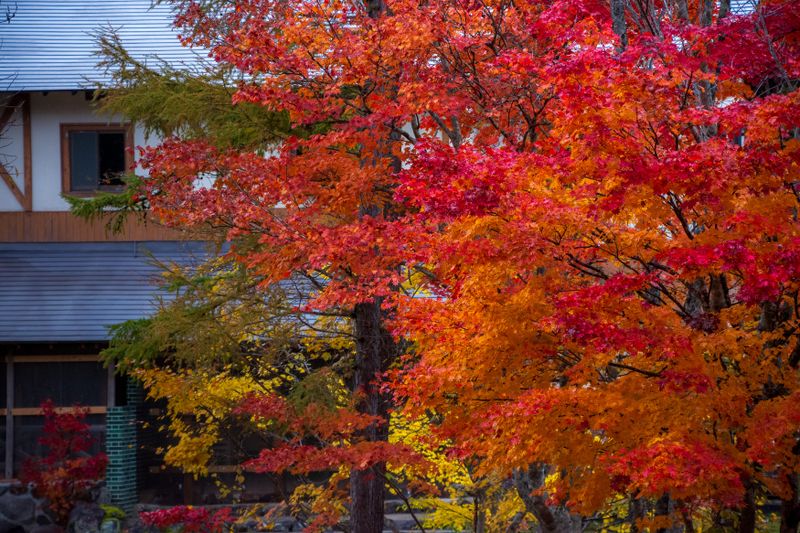
When I first came across the term “workation,” -- an amalgamation of “work” and “vacation” - I’ll admit to having let out a cynical giggle. It sounded like the authorities in Japan had given up on any attempts at getting the nation’s workforce to take a break for more than a day or two. Instead conceding ground to a position of well, how about if we let them bring some work along?
While the “workation” moniker itself may be something relatively new, weary white collar workers across the globe have likely become well versed in something to a similar effect, however reluctantly. Every vacation I’ve had for the past five years has been something of a workation with smartphones and the virulent spread of wifi having effectively ruined any idea that I might be able to escape the reach of overzealous colleagues who care not that I’m trying pour my creative energy into a poolside cocktail.
Here in Japan though the workation concept appears to have taken root in something more proactive and pressing -- the revitalization of rural Japan. Or indeed, its very survival in some cases.
Watch a video about the workation experience on the City-Cost Japan YouTube channel:
In January this year team City-Cost visited the Nishi-awa region of Tokushima Prefecture, on the island of Shikoku. Many visitors might associate the area as a base from which to explore the near-mythical Iya Valley. We were in town though to tour some of the region’s co-working spaces, set up to attract those who could work remotely to the area and help address the issue of a population left in decline by Nishi-awa’s young educated minds leaving for the city and, well, not coming back.
It was an eye-opener to see how the local government and other organizations were breathing life into old merchant homes, providing workspaces among the region’s traditional udatsu townscapes with views to the mountains that guard the Iya Valley.
And as a project to bring life and creative energy back to a region that was once a hub for trade in goods and cultures, it appeared to be bearing fruit.
In the city of Miyoshi shared working-space facility MINDE had received some 18,000 visitors over the period of one year between 2018 and 2019, including extended stays by workers from the headquarters of large companies based in Tokyo. With office space, accommodation, a cafe, tatami lounge and a garden, as well as the distinct absence of any urban chaos, it was easy to see why people came to crack open their laptops in the facility.
During our visit to the facility we were interviewed by a reporter from the local newspaper. When asked what might be done to improve the facility, embarrassingly all I could think to say was, “Well, a couple of sofas and some English-language literature to flick through might be nice.”
They appeared to know what they’re doing in Nishi-awa, being ahead of the workation game to the point that the move from marketing their version of the workation to domestic markets to include international markets had already been made, at the time of our visit. (As if to pre-empt my own skepticism of the workation concept the Tokushima Prefectural Government West District Administration Bureau already had in print an English-language pamphlet explaining the concept and giving examples of how it works, including voices of experience from foreigners who had tried it.)
But then they are experienced hands in this part of Japan. Nishi-awa was selected back in 2017 as a location for a trial satellite office project administered by the Ministry of Internal Affairs and Communications.
Of course, the nearby town of Kamiyama has for years now been drawing Japan’s creative types out of the city and into the mountains, lured by the promise of post-work pizzas homemade under the stars and some of the fastest internet to be found anywhere in Japan.
For this visitor Nishi-awa breathed life into the workation concept, furnishing it with counter desk views to gorgeous scenery and serving up organic coffee on the side. Why, it was enough to make me want to do some work!
The outbreak of the novel coronavirus and subsequent state of emergency, declared in April by then Prime Minister Shinzo Abe, has since seen the concept of the workation take on a new role.
In the “with corona” era the workation is seen as one potential and combined solution for a hesitant populace looking to avoid the crowds of Japan’s marquee tourist attractions and a government trying to reduce the crush of the morning commute. Continued regional revitalization plus work-culture reform.
In October this year a collection of three organizations, the Japan Business Federation (Keidanren), the Japan Travel And Tourism Association, and Workation Alliance Japan (WAJ), announced a joint “Workation Promotion Project.”
Through the project the three organizations aim to deepen understanding of the “workation” among businesses and other organizations (including Keidanren members) by inviting business leaders and managers on monitor tours showcasing the its appeals. The project aims to have companies implementing workation programs starting from fiscal 2021.
Government agencies are also eyeing the workation as one aspect of what is being termed “a new style of travel” in the corona-era. Also in October, the Japan Tourism Agency and the Ministry of Land, Infrastructure, Transport and Tourism announced in a joint press release the holding of a review committee to discuss these new travel styles, which would include experts, representatives of related government ministries, and members of the business community and tourism industry.
Based on the diversification of working styles such as telework, the committee hopes “to promote new travel styles such as “workation” and “bureisure” (business and leisure) and increase opportunities for travel,” according to a statement on the press release.
In November members of team City-Cost were invited to join a workation monitor tour in the Urabandai region of Fukushima Prefecture, organized by the Urabandai Tourism Revitalization Council.
Based out of Daiwa Royal Hotel Active Resorts Urabandai in the village of Kitashiobara. tour participants sampled some of the appeals of what organizers are calling, “workation resort Urabandai” in this case focusing on the sub-themes of “beautiful nature” and “art.”
On the afternoon of the first day of the two-day, one-night tour participants based in Tokyo were taken on a guided walk along the banks of the Goshikinuma -- a multi-hued collection of lakes, ponds and marshes formed after an eruption of iconic Mt. Bandai in the late 19th century.
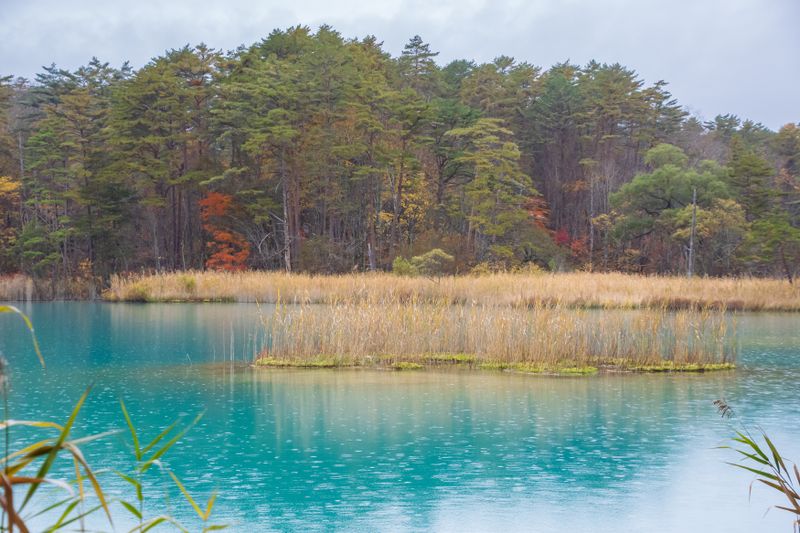
(A hike along the banks of Goshikinuma, part of the "workation" experience)
After check-in at the hotel team City-Cost held a meeting in the hotel cafe during which we discussed the pros and cons of the workation over ice cream parfaits that featured onsen tamago and cookies in the style of works from surrealist Salvador Dali.
Prior to dinner, tour participants sampled an evening visit to the Morohashi Museum of Modern Art as part of the facility’s “Night Museum” event during which visitors can view the museum’s large collection of works by Salvador Dali after hours, as well as enjoy the building’s illuminated exterior. The visit included a talk on how to view art held in front of The Battle of Tetuan, Dali’s gigantic 1962 oil on canvas.
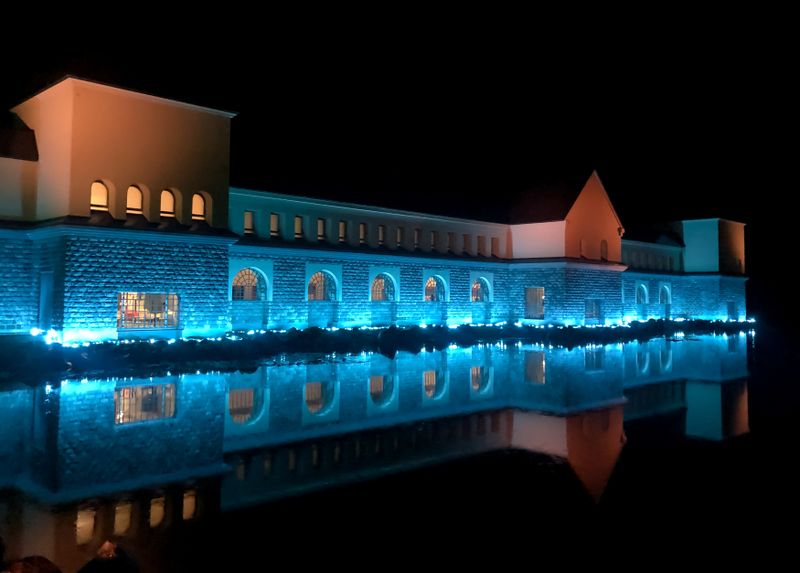
(Morohashi Museum of Modern Art illuminated during its “Night Museum” event)
On day two, this workation tourist began the day at my room’s coffee table, laptop cracked open to deal with work emails, curtains wide open to let in a view of autumn leaves and mountainsides.
After breakfast the workation tour took participants to the Grandeco Snow Resort to enjoy a gondola ride over ski runs awaiting their winter coat, before heading down to the resort visitor center to listen to a talk from Japanese comedian Nasubi. The Fukushima native has, in recent years, devoted much of his energy to environmental awareness and regional promotion, the latter including a successful summit of Mt. Everest.
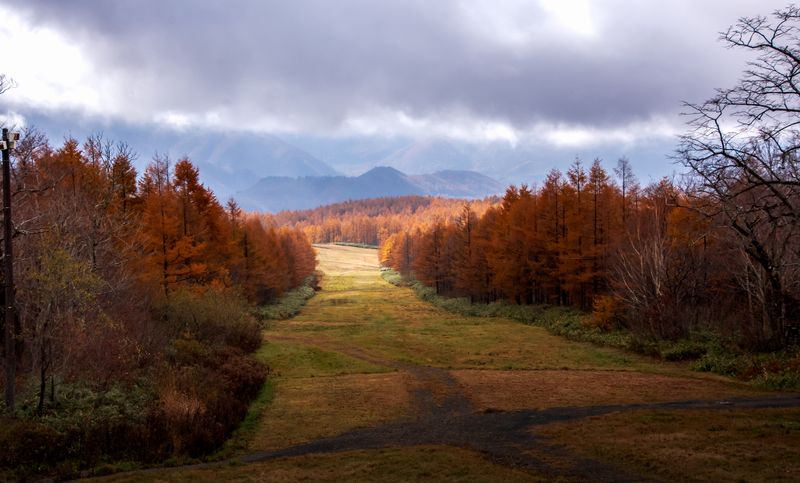
(The "ation" part of "workation," enjoying the autumn colors at Grandeco Snow Resort)
Throughout the workation tour I counted up how much work I was doing (aside from “tour participation” itself) and worried that I wasn’t doing enough. I was, in fact, doing very little, distracted by Urabandai’s spectacular autumn colors and the strain of trying to understand talks delivered in Japanese.
These “distractions” however, are actually a key part of the workation’s remit. The regional revitalization part, where workationers are encouraged to interact with local people, places and culture rather than just remaining ensconced in a hotel room switching their gaze between laptop screen and rural scenery.
The question of the workation’s balance between “work” and “vacation,” it seems to me, does need to be addressed more closely, and ideally before the would-be workationer suggests the idea to their boss.
Just how much work should I be doing and, indeed, why do I need to go all the way to the countryside to do it?
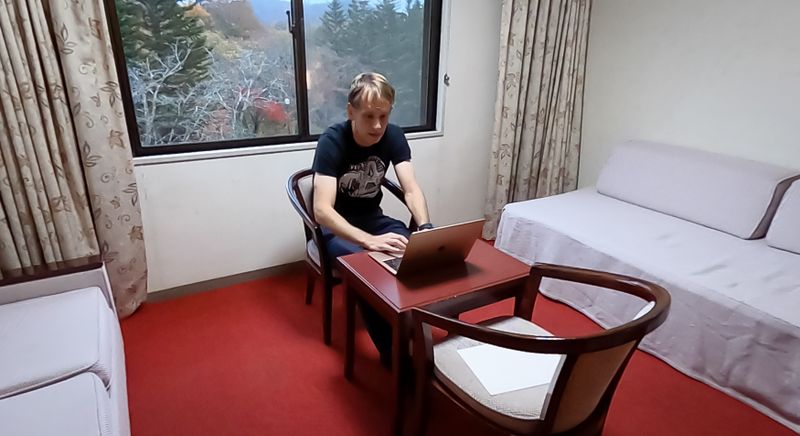
(Hard at work! Active Resorts Urabandai, Kitashiobara, Fukushima Prefecture)
Questions about how the workation can support efforts toward regional revitalization may have been answered and there can be little doubt that in the midst of a pandemic, many workers will likely be happy to switch crowded commuter trains and an island of office desks for a resort hotel room and clean mountain air. Bosses and account managers with a bottom line may have more penetrating questions to ask which in this workationer’s albeit limited experience appear harder to answer.
The outbreak of the novel coronavirus may have caused inbound tourism to all but grind to a halt but it hasn’t stopped authorities and organizations from plotting a way toward grander visions for the workation concept “after corona.”
In documents presented for the first meeting of the above-mentioned review committee on “new travel styles” held in Tokyo on October 23, Toyo University’s Faculty of International Tourism presented the need for systems to better facilitate people being able to take a workation in Japan, including the issuing of visas that would allow foreign visitors to enjoy longer-terms stays in the country under their own resources. In the documents, the university cites the Digital Nomad Visa which came into effect in the Republic of Estonia in August 2020. The visa allows remote workers to live in the eastern European country and legally work for their employer or their own company registered abroad.
Whilst it might prick the ears of the digital nomad to hear of such potential, questions about when the “post corona” era can actually get underway are surely harder to answer right now than any request from a budget-conscious boss to justify your workation expenses.
For now though, and on a personal note, I’ve got my fingers crossed that I can convince the people upstairs. From a lifestyle and all-round wellness perspective, swapping office grays and frantic, sweaty commutes for fresh air and a feeling of calm makes so much more sense.
Related:
Japan getting to grips with telework, fine tuning needed to go fully remote
Tokushima district encourages foreign visitors to mix work and play



0 Comments